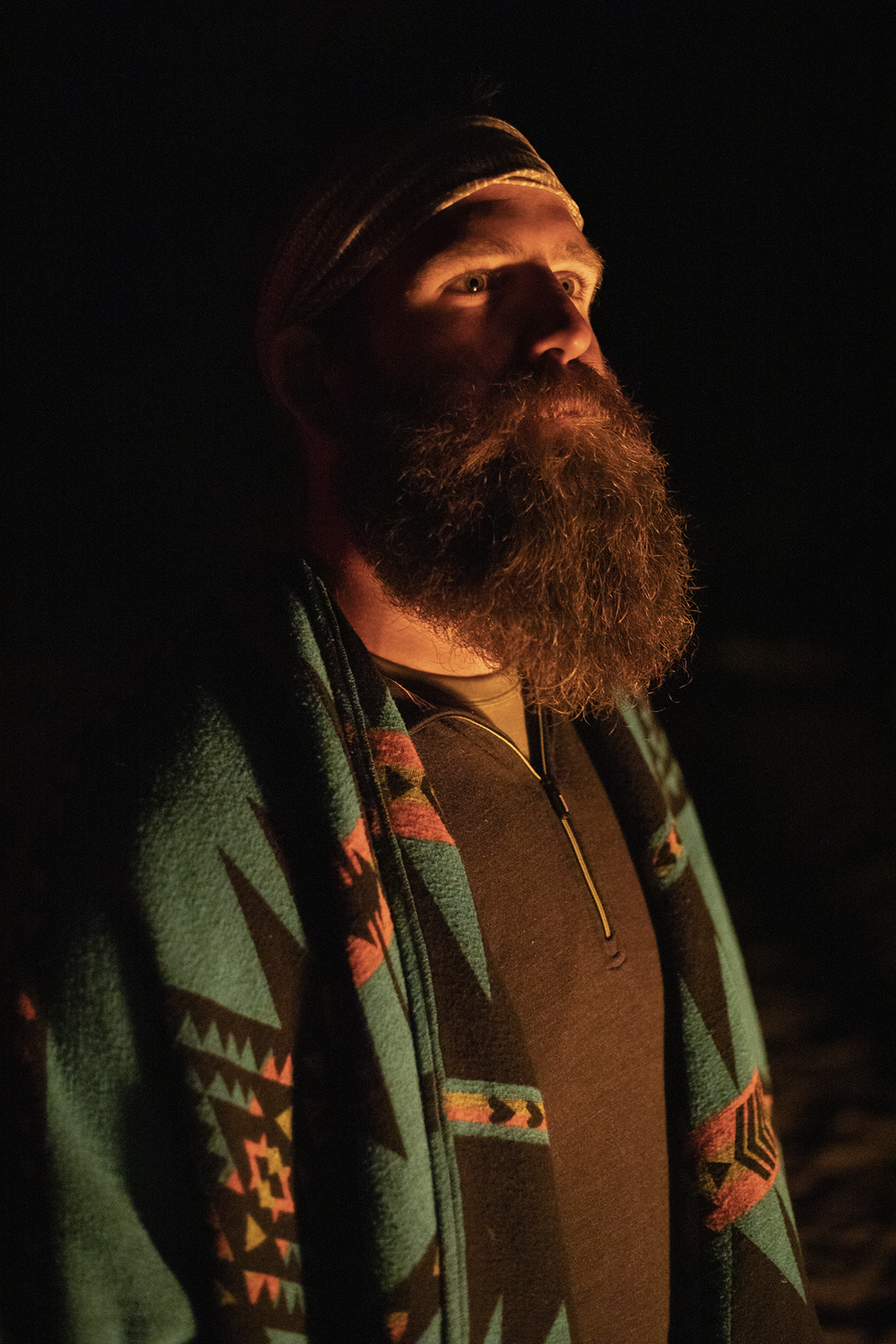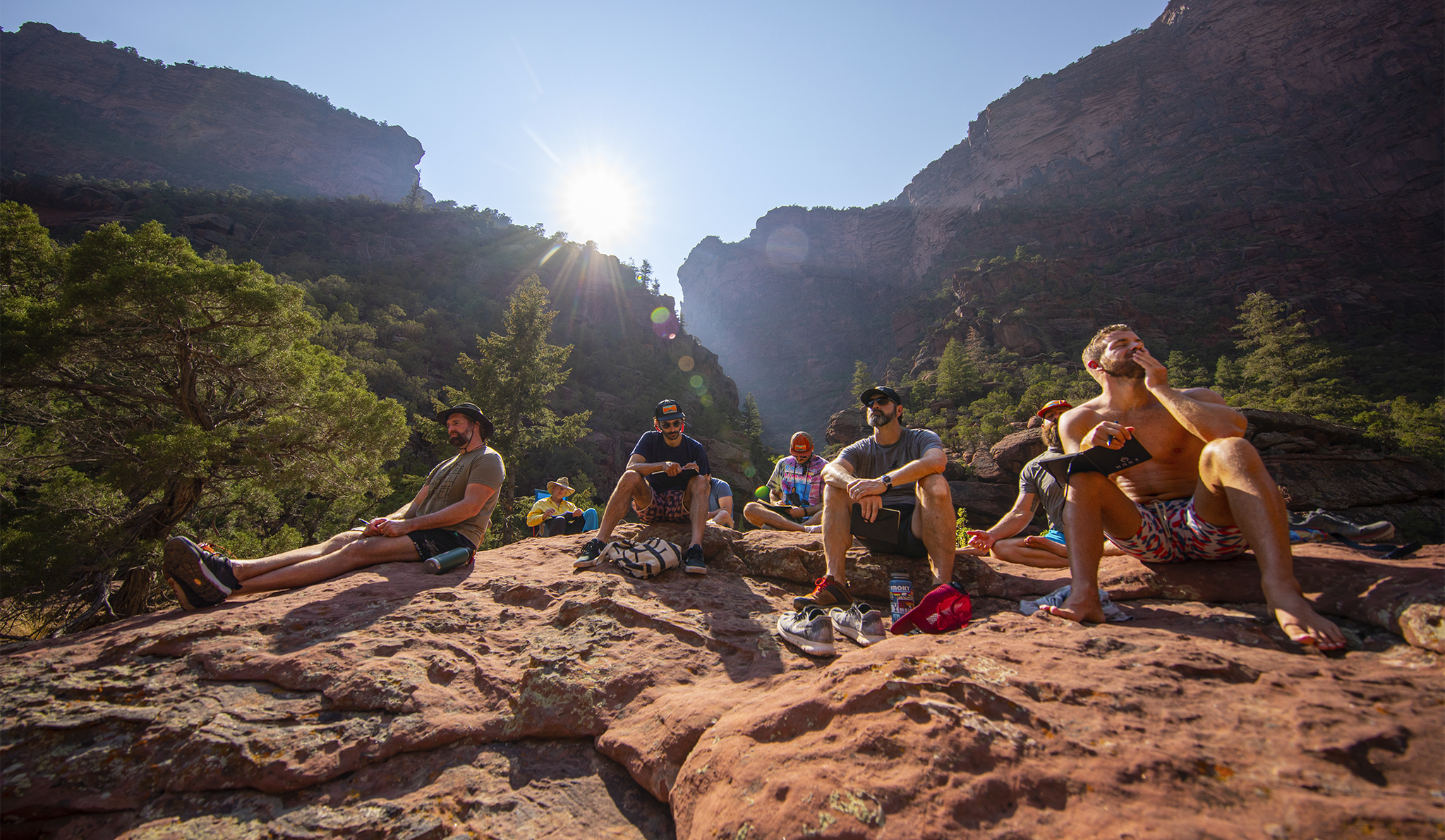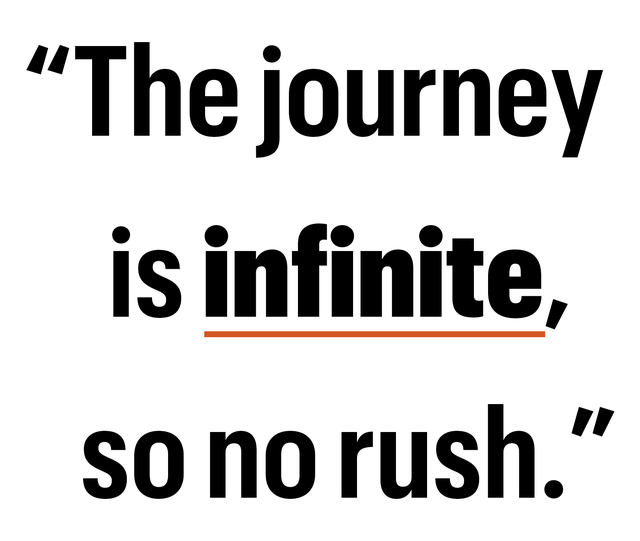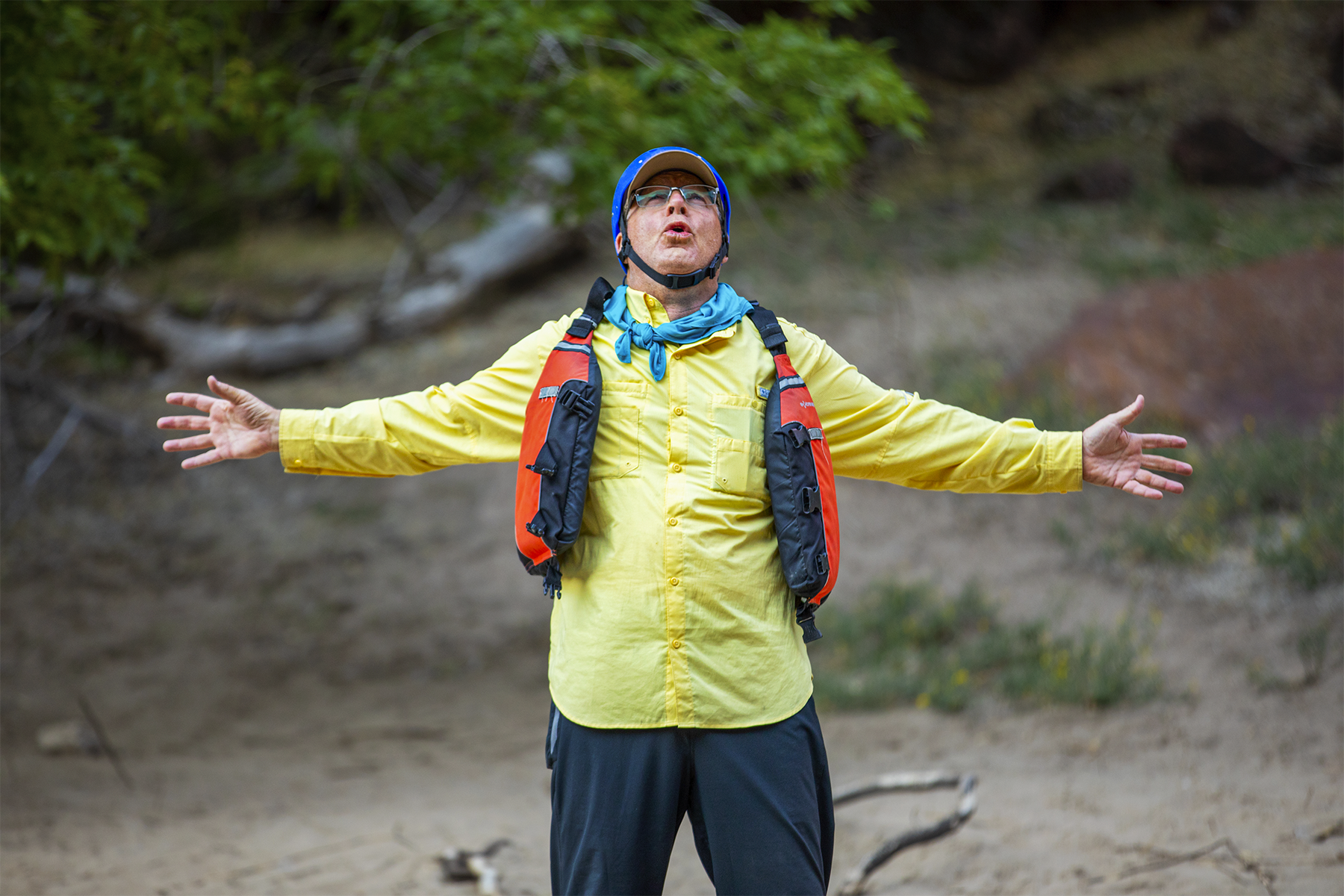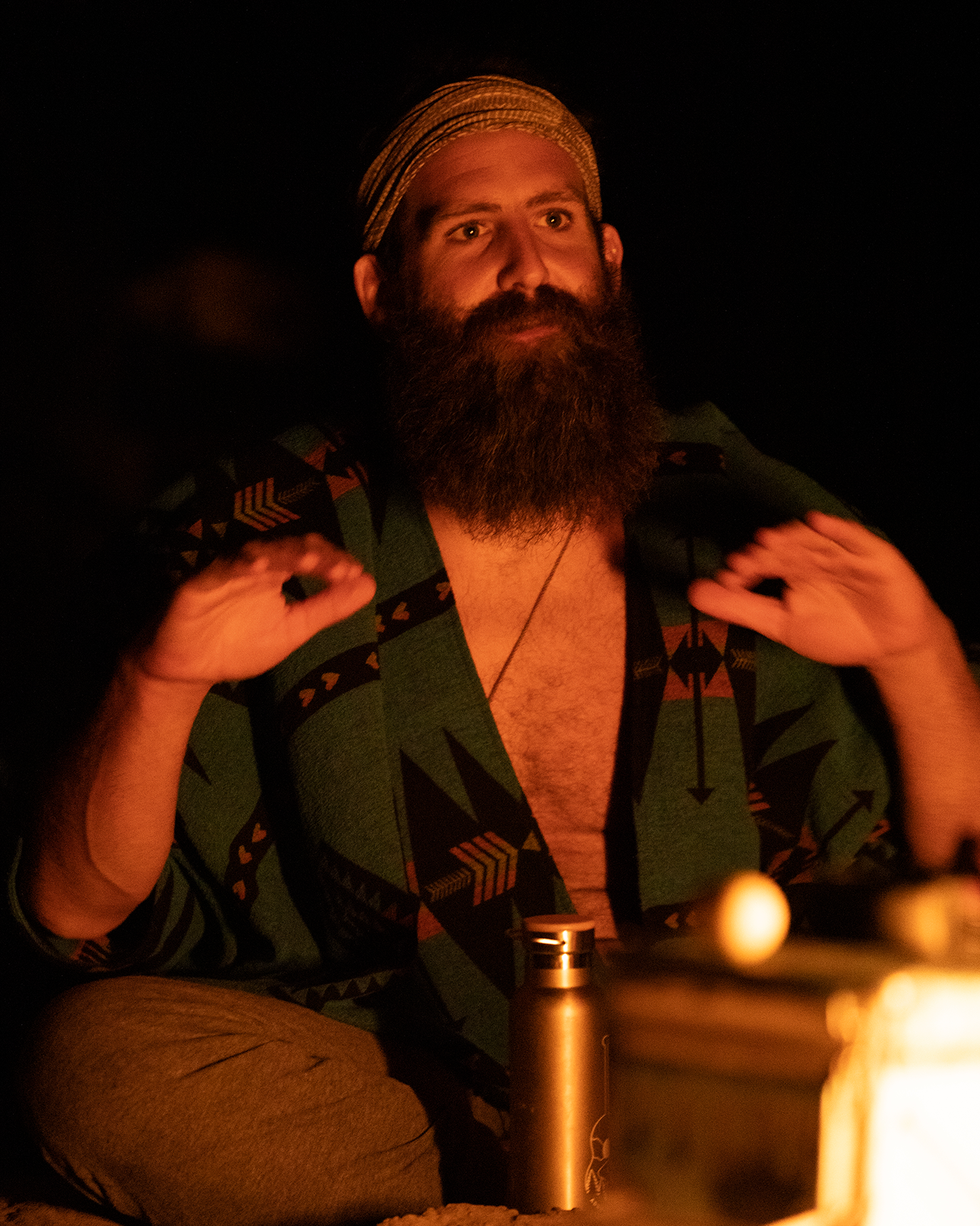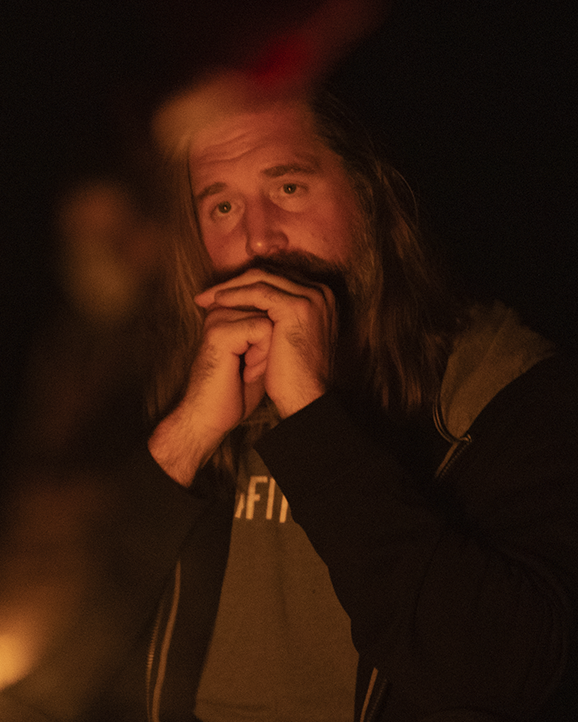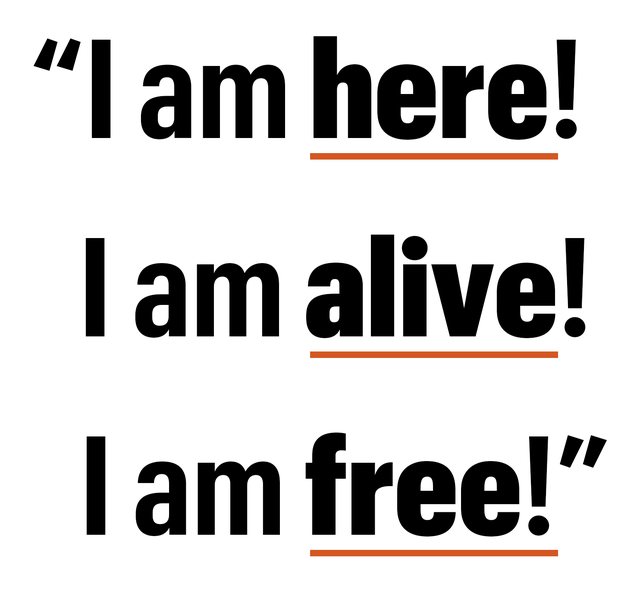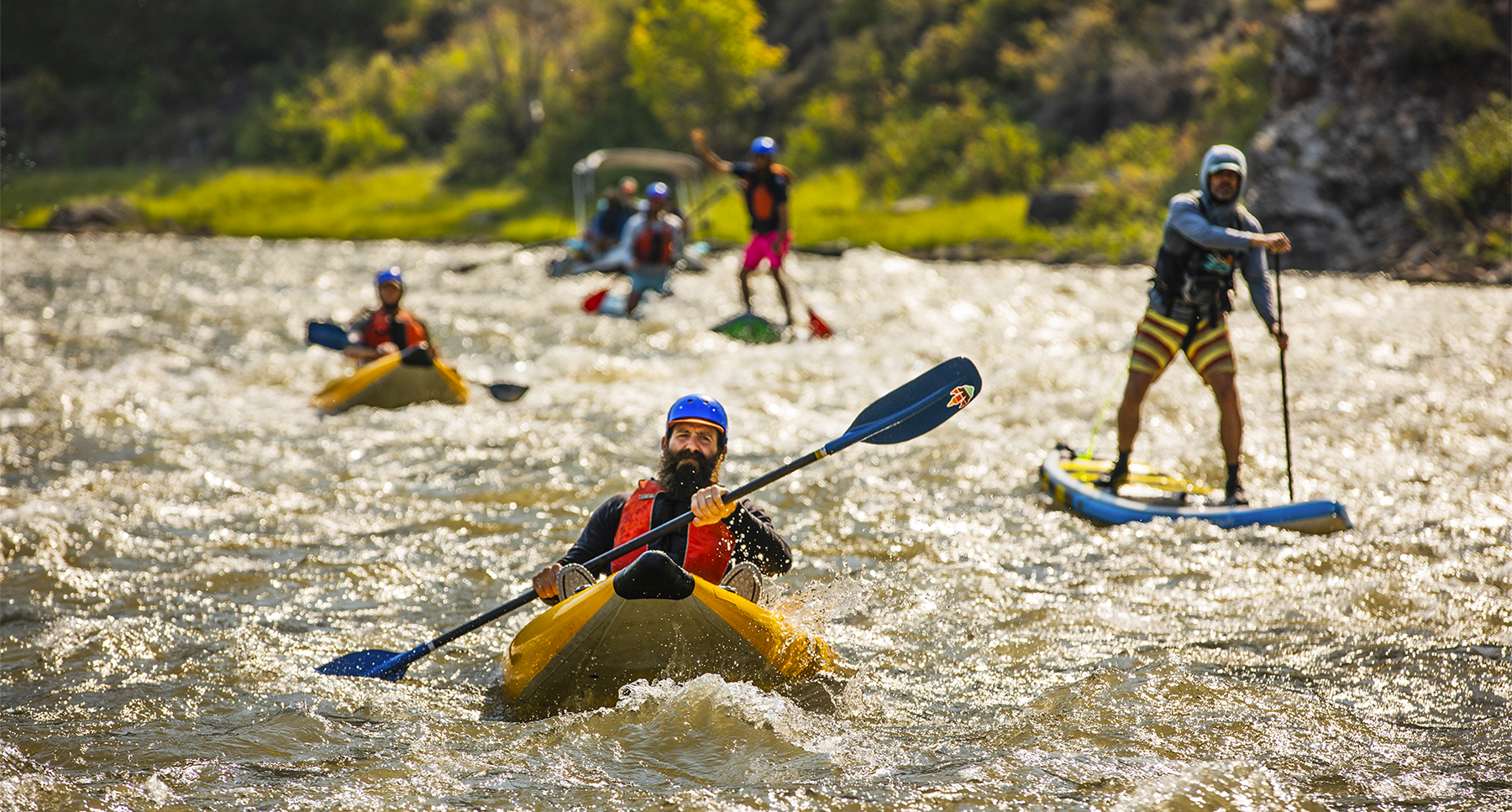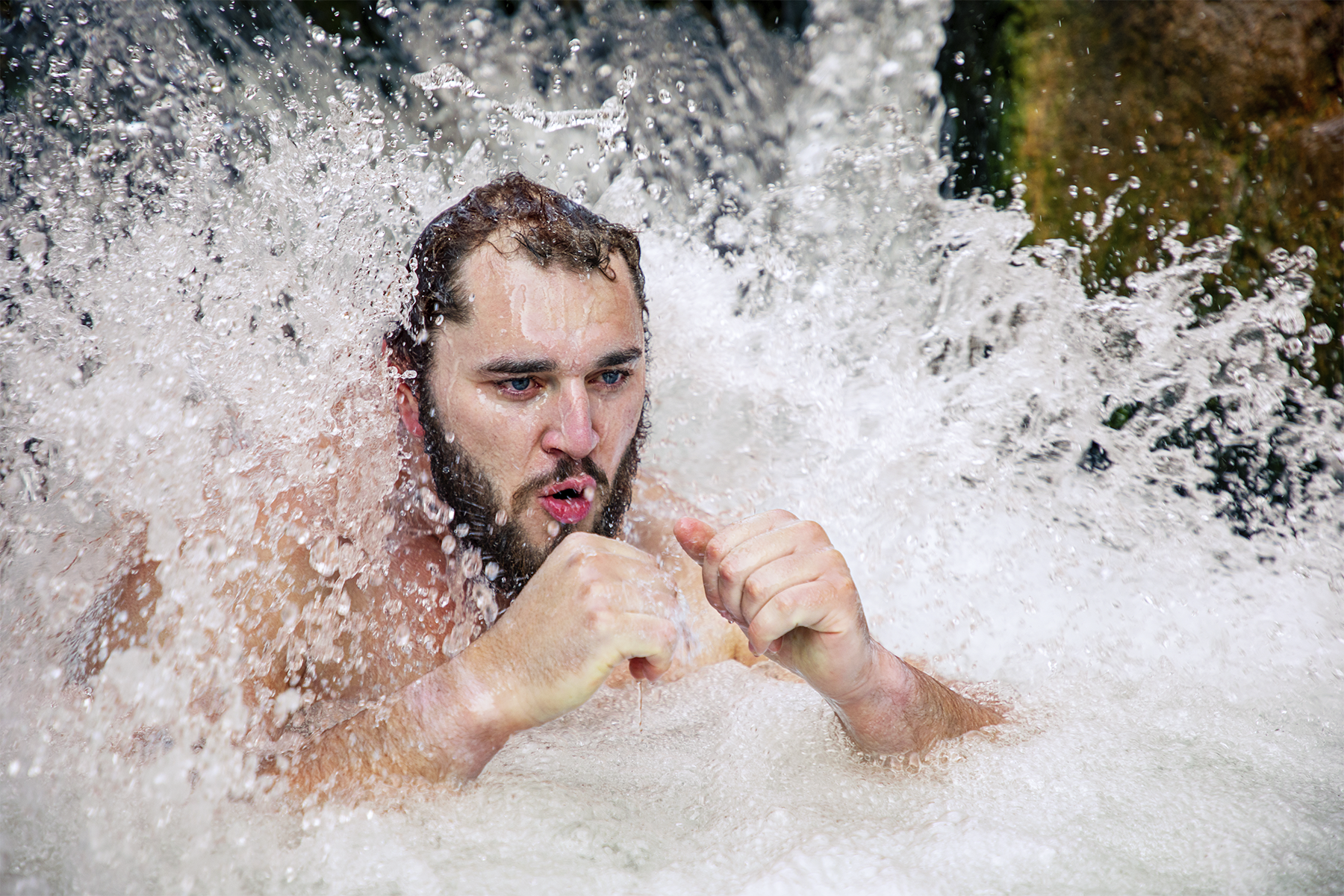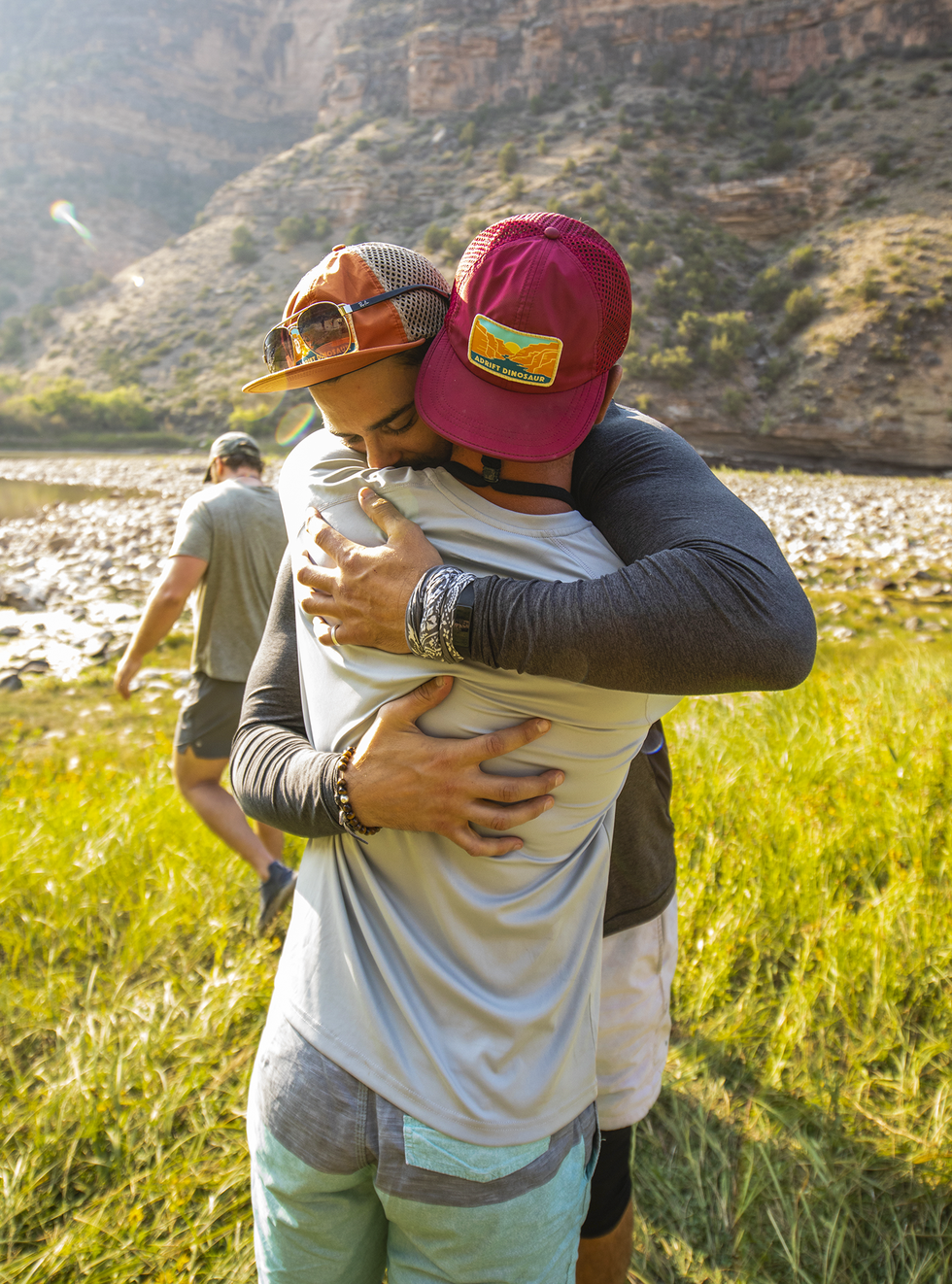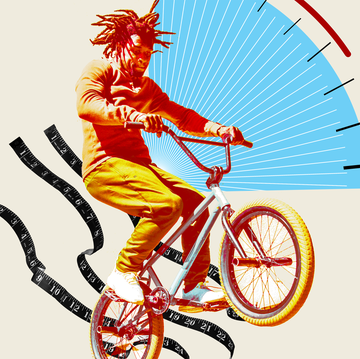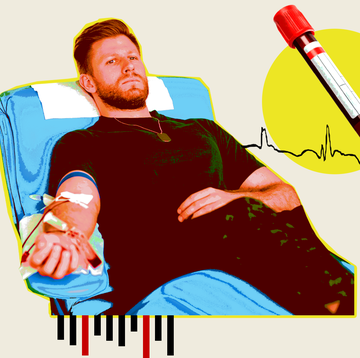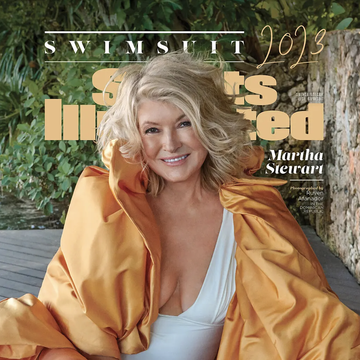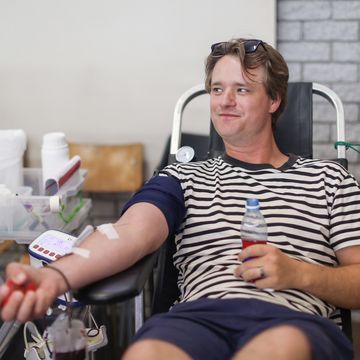WE WERE 24 HOURS into our four-day rafting trip deep within the canyons of Colorado when our wild-eyed leader, Joe Hawley—best known as the impressively bearded former center of the Atlanta Falcons and Tampa Bay Buccaneers—told us to park our rafts, make camp, and prepare to head into the mountains.
Hawley, 33, sported a jade pendant necklace that complemented his turquoise camping gear. All day, he’d been sharing vague spiritual maxims like “What I’ve found is that all of it comes back to presence. The key thing is to be present with everything that comes up.” Then he got specific: “We’re going to be hiking up to a beautiful waterfall and then dropping into a workshop that will help us confront our deepest fears.”
Two hours later, five strangers—all hulking ex–NFL linemen—and I had ascended rocky terrain to reach a ledge about 500 feet above the river, which glistened below like tempered glass. We were sweaty and tired, but Hawley, who is 60 pounds lighter than in his playing days, appeared more energized. He took off his boots and stood barefoot to introduce Ben Harris, a blond and deeply tan “fear alchemist” and podcaster, who had tagged along to lead this workshop.
We’d all been issued journals, so Harris gave us a writing prompt: If fear didn’t exist, what would you do?
Hawley seemed to be already living his answer. “I got this insight to start a community for former athletes, but it scared the shit out of me,” he’d told us earlier. “I always have played kind of small as a leader. One of my biggest fears was being seen and stepping up and having the limelight on me.”
In 2018, at 29, Hawley exited the NFL, having earned an estimated $13 million over eight grueling seasons. All it cost him was his body (a reconstructed knee, torn shoulder cartilage, bone spurs, and a bulging disk) and any real identity beyond the game. So he set out to find himself and explore the country in a van with just his dog. Today he describes that two-year odyssey as his “healing path,” which led him to form the Härt Collective, an exclusive men’s community that he started in 2020 to help former pro athletes become more “emotionally intelligent [and] self-aware” through “heart-centered work.”
As a former Olympic fencer, I’d lived my own version of his story. After winning a silver medal at the Beijing Games in 2008, I ended my career with all-time-high levels of anxiety from consistently hiding my problems, hoping to compensate through my will to succeed. Even after extensive therapy, I still struggle, because my perfectionism often leads to periods of emotional withdrawal. So when I heard about the Collective and its focus on rehabilitating that hypermasculine, win-at-all-costs mentality, I asked to join one of the trips.
Currently, a total of ten members (all ex-NFLers, plus one former NHL player) pay $99 per month for weekly check-in calls with Hawley and exclusive dispatches from a rotating cast of ex-athletes, spirituality influencers, and mental-health experts. They also get access to discounted retreats like this one, which was billed as an off-grid self-help gauntlet that cost $2,200 and would take us through northwest Colorado into Utah along the Green River, a 44-mile stretch of water with about a half dozen class III and IV rapids.
“You say the word vulnerability and automatically walls come up,” Hawley told me. “The Trojan-horse idea was creating these retreats around experiences like whitewater rafting.” Along the way, we’d participate in workshops focused on what seemed to be four emotional pillars of the male psyche: brotherhood, fear, anger, and shame.
Of course, journaling about what you’d do if fear didn’t exist is an exercise we might all benefit from—even if you don’t want to reveal the results. But after ten minutes of writing time, Harris reminded us that we could find commonality in our most fundamental fears and invited us to share. For a long moment, the men looked everywhere except at one another. Nobody volunteered.
THE FEAR EXERCISE was supposed to explore the second of our four emotional pillars, but judging by the hesitation among the group, it was clear our earlier attempts at brotherhood hadn’t fully paid off. The day before, in a dirt pasture full of balsamic-scented cottonwoods, we’d paired off to stare into a partner’s eyes for five long minutes. Then Hawley told us to say “I love you” to each other.
My partner, Garrett Reynolds, 34, a six-foot-seven, 290-pound ex-Ram with a blond man bun and beard, had gone first.
“I love you . . . man,” he said with a thick Tennessee twang.
I said, “I love you” back but not without some effort.
Later, another former player explained why Reynolds’s slight improvisation might have been important: “I love you, man, but I’m not gay,” he said, causing the whole group to laugh hard—me included.
The moment was funny but made me feel a bit uneasy. More than a decade ago, I’d chuckled at hundreds of similar locker-room jokes while wearing a plastered smile to hide my discomfort with a culture that awards status to those who egg each other on. I worried about fitting in with seemingly powerful and confident men.
When Harris invited us to share our fears at the top of the cliff, I saw it as my chance to be a team player and volunteered to go first. Harris walked me through a logic exercise that reminded me of my time spent at Tony Robbins seminars. First, I read what I’d written: I would be more openly affectionate toward my wife. He asked what stood in my way. I shared with the group the same thing I’d shared at many men’s groups before this: For years, I’d struggled to perform in bed because I was so worried about disappointing my partner—and that had probably created a strong fear of failure.
“So fear does the exact thing you don’t want to do, right?” Harris said. “If [you] truly want to be loved and loving, [you’ve] got to give love.” I agreed with that idea, although it seemed pretty obvious, and even told the group that I felt lighter, in hopes that others might be inclined to share next.
The other men still hesitated. “This is a safe space to really look at [your] stories and shift something within yourself,” Hawley said in a husky but extremely calming voice. Finally, Dustin Stanton, 27, a thick-shouldered, scraggly-bearded former member of the Cowboys, admitted in a somewhat businesslike tone that he’d struggled with the journaling part but feared making mistakes as an entrepreneur. Shane Hall, 41, a gray-streaked, southern-drawling ex-Seahawk, offered a vague description of wanting to “love more.” But he, too, hadn’t written much down, which he chalked up to a broader fear of “being seen.”
Next, Jeff Shugarts, 32, an ex-Buccaneer with a handlebar mustache and a tie-dye T-shirt, said somewhat cryptically that he wanted to tell the truth more often but was afraid of losing the people he loved. The last two men, my former eye-gazing partner and Dave Stalls, 66, a wiry-haired ex-Raider, simply declined to share.
When I looked over, a couple of the guys who were sitting nearby avoided eye contact. It felt like we weren’t growing closer or healing together; we were widening the gap.
THE IDEA OF MEN going into the wild to learn more about themselves together isn’t new—and nature self-help retreats exist in plenty of different flavors, including the ManKind Project, which focuses on outdoor trips based on the hero’s journey, and Evryman, which offers experiences as a sort of emotional CrossFit. During his van years, Hawley attended an Evryman retreat and later invited the organization’s cofounder Dan Doty to join the Härt Collective’s advisory board. He met his now wife after joining Fit for Service, the coed self-development community led by Austin-based fitfluencer and Covid disinformationist Aubrey Marcus that hosts summits with Burning Man– style rituals and ecstatic dance. Hawley’s camp is essentially a mash-up of these styles. He’s also baked in lessons from his mentor, a shamanic and Jungian-based experiential psychotherapist named James Frazier; books like The Monk Who Sold His Ferrari; and his sessions with ayahuasca (13 and counting).
It was only after his career ended, Hawley says, that he realized that his NFL managers and medical staff had weaponized his masculinity against him, making him feel like a “bitch” if he had issues with physical pain. With his ex-pros, Hawley says, he hopes to model a healthier kind of masculinity, one that could inspire other athletes or even fans to rethink how they approach the world. To stay accessible to everyone, he maintains an inspirational-quote-heavy Instagram with nearly 40,000 followers and a YouTube channel with nearly 10,000 subscribers, plus his Quantum Coffee podcast, dedicated to “curiously exploring the deeper, unanswerable questions of the universe.” He continues to work with Frazier and recently enrolled in a three-month somatic-trauma training course.
There’s always the chance that a retreat leader without proper training can create an experience that just isn’t helpful for anyone, says Keith Russell, Ph.D., a social-sciences professor who cowrote the academic manual Adventure Therapy. But there’s an easy way to tell if your group is working. “If the community clearly means something to the other men, they’ve learned something about themselves, and there’s sadness and hugs and embracing, then I think that the experience was a success,” he says.
As the trip progressed, I began talking often with Stalls, the oldest of all the men. He’d been a kayaker in his earlier years and was thrilled to reconnect with the river and powerful rapids. Nearly a decade ago, Stalls said, he had to step down as CEO of Big Brothers Big Sisters of Colorado because he was having trouble expressing his ideas and was experiencing emotional volatility. He’d won two Super Bowls, but it appeared that too many hits to the head during his career had exacted their toll. He began extended stints at a Buddhist retreat center in the Rockies to try to cope.
“I am very aware of what I have progressively been losing as far as cognitive and brain function,” Stalls said. “In January, [my doctors] said, Yes, you do have what we consider early dementia.” He was waiting on the results of a scan to determine if it might be Alzheimer’s. His overarching concern was that his root problem might be CTE, a condition that can be diagnosed only after death. Stalls told me that uncertainty about his declining health often led to terrifying thoughts. That’s something that Shugarts, the mustachioed tie-dye fan, also struggled with, having recently lost college teammates, including one of his best friends, to suicide and having considered the act himself. “I wrote a suicide letter to my brothers, and I don’t remember writing it,” he’d told us the previous day after we’d made camp, only to fall silent during the early workshops.
Stalls remained reluctant to dive in, too. He told me that he’d actually shared his fears about CTE with a few members of our squad at a different Collective retreat a few months earlier, but the conversation “kind of died.” He had been eager to talk more, but the others were not.
AFTER THE BROTHERHOOD eye-gazing gambit and the fear confessional, Hawley began the next step toward enlightenment by ripping a giant fart. It was after sunset on the second day, and he wore a Navajo-pattern poncho while sitting cross-legged in front of our propane-fueled artificial campfire. Once our chuckles died down, Hawley’s face tightened as he explained what was essentially the anger-management part of the trip. We would begin with a sharing circle, followed by some catharsis through a session of ecstatic dance.
“To be totally open and honest, I’ve been, over the last hour or so, feeling these old stories and patterns come up with fear around what I’m going to talk about and just how it’s all gonna play out,” Hawley said. Then, looking at each of us closely, he told us how important it is for athletes, especially football players, to release the anger they’d channeled into their sport, or else it could control their lives.
When it was his turn to share, Stalls said that, after football, he no longer understood how to uncage his inner animal. Shugarts instantly related. He lifted trembling hands, noting that just hearing those words triggered old football conditioning to funnel his rage and prepare to attack. “Sometimes over things that don’t matter at all, my body starts going into this mode when I’m getting ready to kill somebody,” he said. In the hazy firelight, I watched as several of the men sat forward in their chairs, their bodies tense as they nodded.
I tried to relate as best as I could. “If my emotions fall out of the optimal zone, it’s like I don’t want them,” I said, before mentioning that I’d actually felt jealous of men who seemed to knock down their barriers at other retreats, since they made me feel like I was a fake somehow. “When’s my emotional breakthrough?” I asked, immediately regretting it because I sounded whiny, until I heard murmurs of support.
Hawley stood up and raised his arms in preparation for the dance while our river guides began banging on water cans and bongo drums and someone strummed an acoustic guitar. Hawley’s advice for this part was a little lean: “So this is obviously a vulnerable thing,” he said. “If you’re the kind of person that’s uncomfortable, and you don’t usually participate, give it a try.”
At first, I stared down at the sand and moved my body stiffly from side to side. When I looked over at Shugarts, he seemed more uninhibited but had also just returned from the woods, where he’d been hitting a weed vape. Hawley began chanting nonsense words—Ayyy-Yaah-Ohhh-Yaaa—but sounded hesitant until Harris whooped loudly, breaking the tension.
“I’m here!” Hall yelled into the night.
Then Stalls made a guttural braying sound, lifting his arm in front of his face to simulate an elephant trunk.
Soon everyone was making animalistic sounds or shouting their own guttural battle cries. Possessed by the mood, I tore off my shirt, crouched to the sand, and began banging my fists like an ape. Hawley ditched the poncho, and other guys stripped bare-chested. Suddenly, Stanton abandoned his businesslike tone and led the group in a ridiculous chanting refrain— an homage to our steel-crate campfire:
Fire in a Box!? Fire in a Box!
Fire in a Box!? Fire in a Box!
When I looked around, the mood was lighter, almost joyful. For the first time all trip, I felt like I belonged.
“THE TIME OF the lone wolf is over,” Hawley read dramatically, citing a Hopi Elder passage to commence what he called our silent float. The activity—a quiet half hour of paddling to take in the power of nature—was a tradition established by Adrift Dinosaur Adventures, the rafting company that guided our trip. It was midafternoon on day three, and we still had 30 miles left. I noticed that the canyon around us had changed from dark quartzite to chalky sandstone, smoky limestone, and reddish shale. For me, it was symbolic of how life can surprise you if you’re willing to look closer, and that led to thoughts about the previous night’s fire dance. There I glimpsed the person I want to be: spontaneous, open, fun. That act of letting go felt different from the other exercises, like I was closer to my best self.
The river widened, and we passed by a thousand-foot wall of eroded gray rock in an area called Echo Park. Hawley broke the silence by inviting us to shout a mantra. It was three simple statements:
I am here!
I am alive!
I am free!
We shouted them together, and the words echoed in the void. Looking at the other guys, I could see in their eyes that they were energized by the moment.
Later, as the sun slid behind the mountains, we sat in a secluded clearing near the riverbank. The air turned crisp as we prepared for our final workshop, on shame.
“Shame doesn’t let love in,” said Hawley, who has been open about his own struggles with body image and pornography. “Ninety percent of [healing] is speaking out loud.”
We spent more time journaling about the harsh ways we personally judge ourselves, and then Hawley invited us to share. This time, Reynolds began confidently: He described how, when he was young, he rarely misbehaved to avoid disappointing his father, a man he deeply respects. He started to tear up as he talked about his struggles with dyslexia and how, despite his size, he’d always had trouble standing up for himself when others put him down. When Reynolds got choked up, Hawley stepped across the circle and knelt beside him, placing a hand on his chest.
“What could your father say that you needed to hear?” Hawley asked.
“‘I’ll still love you even if you fuck up,’ ” Reynolds said with tears running down his face.
He was the first of our group to openly sob, and both Stalls and Stanton immediately softened their gaze and leaned toward him, offering visible support. As I watched Reynolds work through his emotions, I had a jolt of envy, but then it vanished. I honestly felt for him.
After a long minute of silence, Reynolds cut the tension. “That was good shit!” he said, smiling broadly.
When it was my turn, I decided to just admit it: Looking down, I told the group I was worried that I’d been really just creating a performance out of sharing my bedroom anxieties rather than actually processing them.
“Would you like to drop into it?” Hawley asked in his casual way of suggesting exploring something important even deeper.
I said yes.
“Think back to when [you] started your sexual escapades,” he said.
I thought of a moment with my first girlfriend—I was sixteen, sweaty, virginal, and failing to get hard. When Hawley asked me what I was feeling in my body as I shared this, I told him: I had a knot in my stomach and was having some trouble breathing.
If I could go back, Hawley asked me, what would I say to her? At first, I totally blanked, but then, as I stared into the encouraging faces around me, the words arrived: “I’m not ready.” I immediately felt more relaxed and started welling up.
“For what it’s worth,” said one of the men a few minutes later, “I didn’t detect an ounce of performance.”
As we closed the exercise, it was clear that Shugarts was wrestling with his own thoughts again, and he tried to explain why he gets so tongue-tied. “I’ve been to some dark places and spoken at a lot of funerals . . . and when I start to take on some of [those feelings], I get scared that I won’t be able to come back,” he said, his voice heavy with emotion.
Hawley reminded him that we were there to support him and, even off the river, always just a phone call away. “And don’t worry: The journey is infinite, so no rush,” he said. “Energy is just going to be released, and we’re going to be finding new levels of freedom. . . . I’m really so grateful for you showing up and being a part of this.”
ON THE FOURTH and final day, we woke up early for coffee and bagels before tackling the final 18-mile stretch of river. Reynolds said he hadn’t expected to share so much and thanked us for giving him “the space to kind of work through that.” As we broke camp, Shugarts said that just packing up to go home gave him a pit in his stomach: “I was, like, holding back tears. They were happy tears [and] sad tears. And I’ve never felt more alive in my life.”
Once we got back on the water, Hawley warned that no matter how openhearted we felt in that moment, returning to the real world would pull us back into old patterns. “The key is, How can I hold that [feeling of presence]?” he said. “That’s contagious. That’s the ripples [we can] send out.” After hitting a few more rapids, we pulled up to the concrete boat ramp and all jumped into the water. Then we worked together to lift each raft and heave it onto a nearby trailer.
When I called Stalls a few weeks later to check up on his Alzheimer’s test results, he said things were looking promising, something he’d shared with other Collective members during their weekly teleconference. “I feel less alone,” he said. “I do not hang out with other football players, so this group is unique.” Hawley later told me that he felt grateful to see how “lit up” Stalls was and how everyone else was supportive. “That’s the vision I have for this community,” he said. “Even if [the results were] the other way around.” He added that Shugarts still had “a lot to process, but I think he’s showing up and developing the tools and the connection to move through that.”
Hawley was already planning more ways to reach anyone who might benefit from this work. But on the last morning of the retreat, he had stopped to reflect on his journey: “Every athlete’s career comes to an end, and it’s like, Who am I? What’s my purpose? I feel like I’ve found it,” he said, gripping the bridge of his nose while crying on the bank. Instinctively, I joined the sweaty, stinky group of men who linked arms and surrounded him. It was more than a huddle.
This story originally appeared in the January/February 2022 issue of Men's Health.


